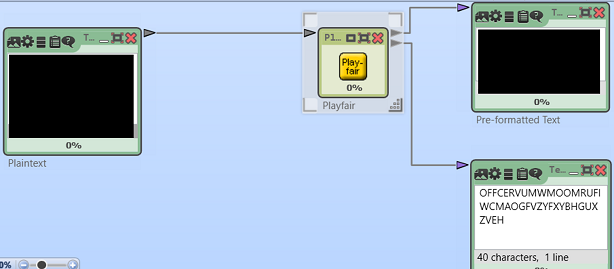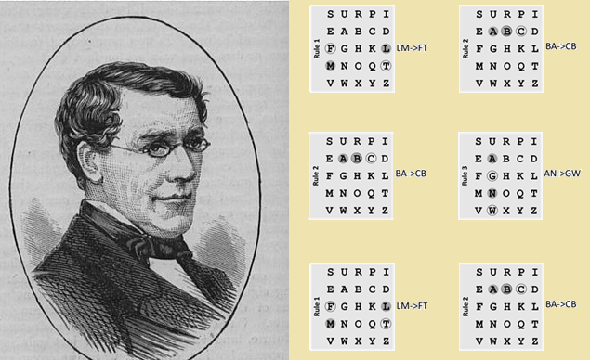My readers have shown that a Playfair cryptogram consisting of only 50 letters can be broken. Here’s a Playfair challenge with only 40 letters. Can you break it, too?
The Playfair cipher, invented by Charles Wheatstone in the 19th century, is a simple encryption method. It is more secure than most other manual ciphers. However, the Playfair can be broken with Hill Climbing (which works even better if Simulated Annealing is included), provided that the ciphertext is long enough.
Earlier this year, George Lasry, …
… who is one of the world’s leading experts in breaking historical ciphers, solved a Playfair cryptogram consisting of only 50 letters I had introduced on this blog. As far as I know, this is the current world record in breaking a Playfair with a random matrix (I know that US cryptanalyst Alf Monge broke a 30 letter Playfair in the 1930s, but this one was based on a matrix created with a keyword, which made things easier).
In order to check if a 50 letters Playfair is the shortest that can be broken, I decided to create a Playfair challenge based on a ciphertext with only 40 letters.
How the Playfair works
The Playfair cipher substitutes letter pairs. So, the cleartext needs to be written as a sequence of letter pairs (the following cleartext is a Shakespeare quote taken from Robert Thouless’ life-after-death experiment):
BA LM OF HU RT MI ND SG RE AT NA TU RE SS EC ON DC OU RS EC HI EF NO UR IS HE RI NL IF ES FE AS T
The Playfair cipher requires that no letter pair consist of two equal letters. Therefore, we add an X between the two Ss:
BA LM OF HU RT MI ND SG RE AT NA TU RE SX SE CO ND CO UR SE CH IE FN OU RI SH ER IN LI FE SF EA ST
If the number of letters in the cleartext is odd, another X needs to be added at the last position, but this is not the case here. Next, we set up a 5×5 matrix containing the letters of the alphabet in a random order (we identify the J with the I, in order to get a 25 letter alphabet):
S U R P I E A B C D F G H K L M N O Q T V W X Y Z
As you might have noticed, the letter order in the matrix has been derived with the keyword SURPRISE. It would be more secure to use a completely random order of the letters.
Now, we replace the cleartext letter pairs (BA, LM, OF, HU, …) according to the three Playfair rules. Here are the rules in a diagram:
Here are the same rules in text form (I refer to the letter pair to be replaced as XY):
- If X and Y are not in the same column and not in the same row (this is the most frequent case), form a rectangle and replace the two letters by the other two corner letters (the upper cleartext letter is replaced by the other upper letter in the rectangle, the lower cleartext letter by the lower one). For instance, LM becomes FT.
- If the two letters stand in the same row, each one is replaced by its right neighbor. Here, BA becomes CB.
- If the two letters stand in the same column, each one is replaced by its lower neighbor. In our example, AN becomes GW.
When we apply the Playfair rules on our cleartext with our 5×5 matrix, we get the following ciphertext:
CB FT MH GR IO TS TA UF SB DN WG NI SB RV EF BQ TA BQ RP EF BK SD GM NR PS RF BS UT TD MF EM AB IM
How to break a Playfair encryption
Using a computer, there are two ways to attack a Playfair cipher:
- Dictionary attack: If a keyword has been used for creating the matrix, it is possible to break a Playfair cipher by key word guessing. For instance, the word SURPRISE is contained in virtually every English dictionary, so a computer that tests one keyword candidate after the other will sooner or later find it.
- Hill Climbing: Hill Climbing is the current super-algorithm of historical codebreaking. As George Lasry has proven, Hill Climbing (enhanced with Simmulated Annealing) can break a Playfair cryptogram of 50 letters.
There are several books that explain how a Playfair can be broken without computer support – for instance Helen Fouché Gaines’ Cryptanalysis, André Langie’s Cryptography, and William Friedman’s Military Cryptanalysis. The concept is to guess a few words in the plaintext and to derive the 5×5 matrix based on the peculiarities of the Playfair cipher (for instance, if AB->XY then BA->YX).
However, breaking a Playfair cryptogram this way is pretty difficult, especially if the ciphertext is short. To make things not too complicated, the books mentioned above use messages containing several hundred letters for demonstration. In addition, these books assume that a few words of the plaintext are known or can be guessed. None of these books describes the complete Playfair codebreaking procedure, as this would require too much space – instead, they simply omit most of the trial-and-error reckoning involved in breaking a Playfair cryptogram.
A new Playfair challenge
Here is a Playfair-encrypted text I created:
OFFCERVUMWMOOMRUFIWCMAOGFVZYFXYBHGUXZVEH
Can a reader break this challenge? Here are the details:
- The ciphertext has exactly 40 letters (spaces not included). The plaintext is in English.
- I used the software CrypTool 2 for encryption. As far as I know, CrypTool implements the Playfair cipher exactly the way it is explained above.

- The keyword is a random transposition of the alphabet. No keyword is used. So, a dictionary attack won’t work.
As mentioned, solving this challenge might set a new record. Good luck!
Follow @KlausSchmeh
Further reading: A mird in the hand is worth two in the mush: Solving ciphers with Hill Climbing
Linkedin: https://www.linkedin.com/groups/13501820
Facebook: https://www.facebook.com/groups/763282653806483/





Kommentare (11)